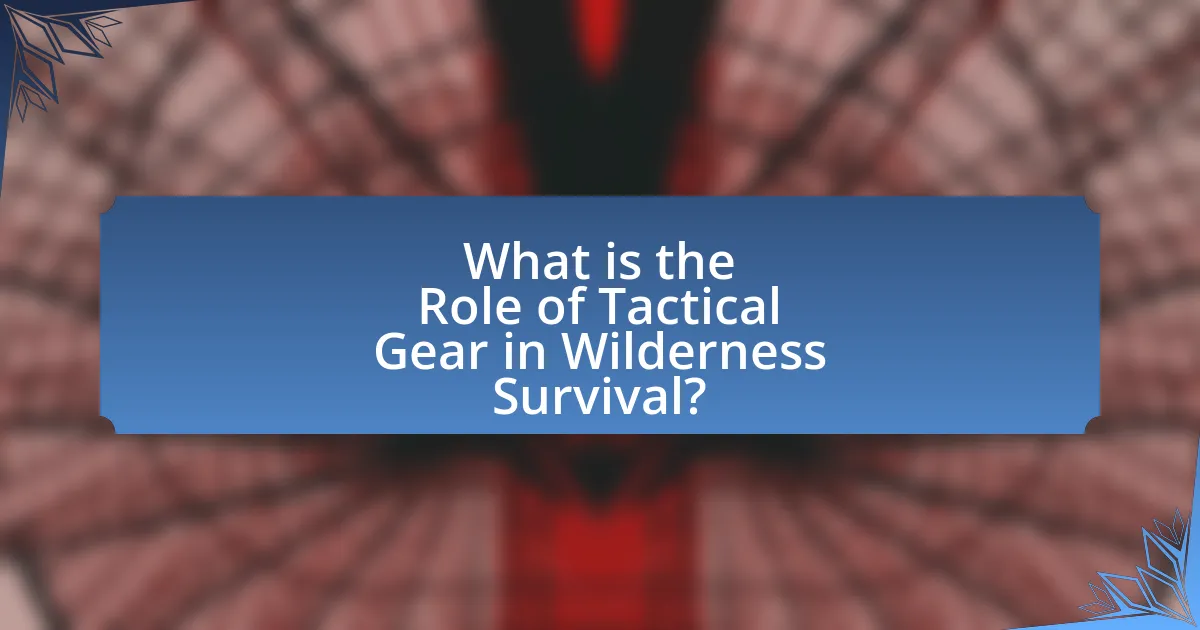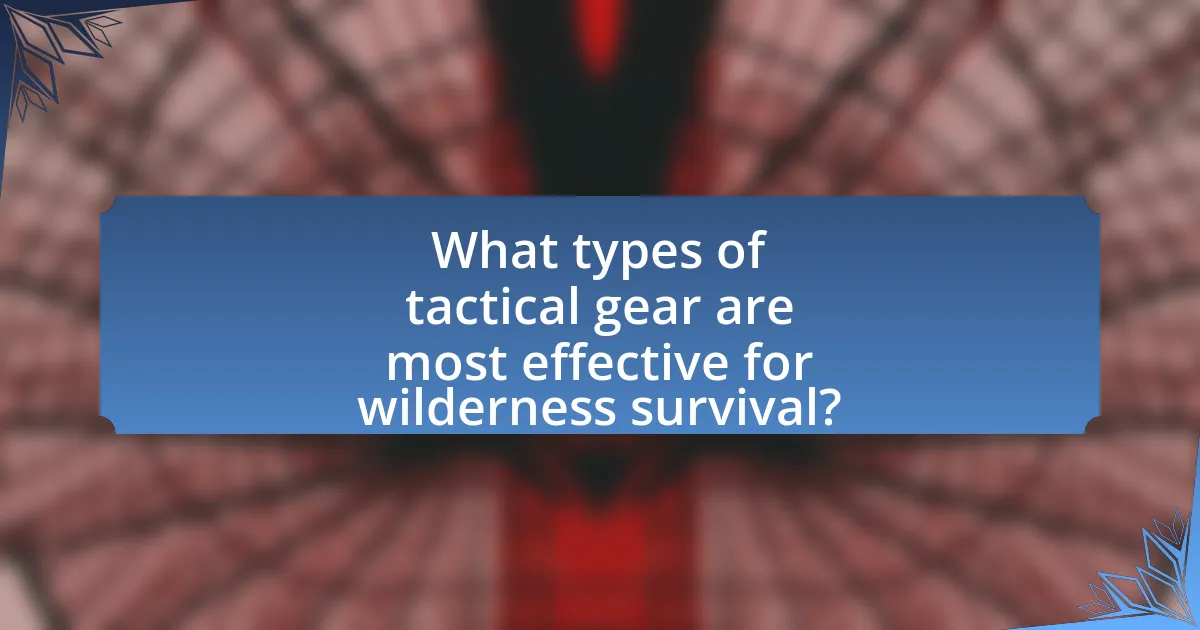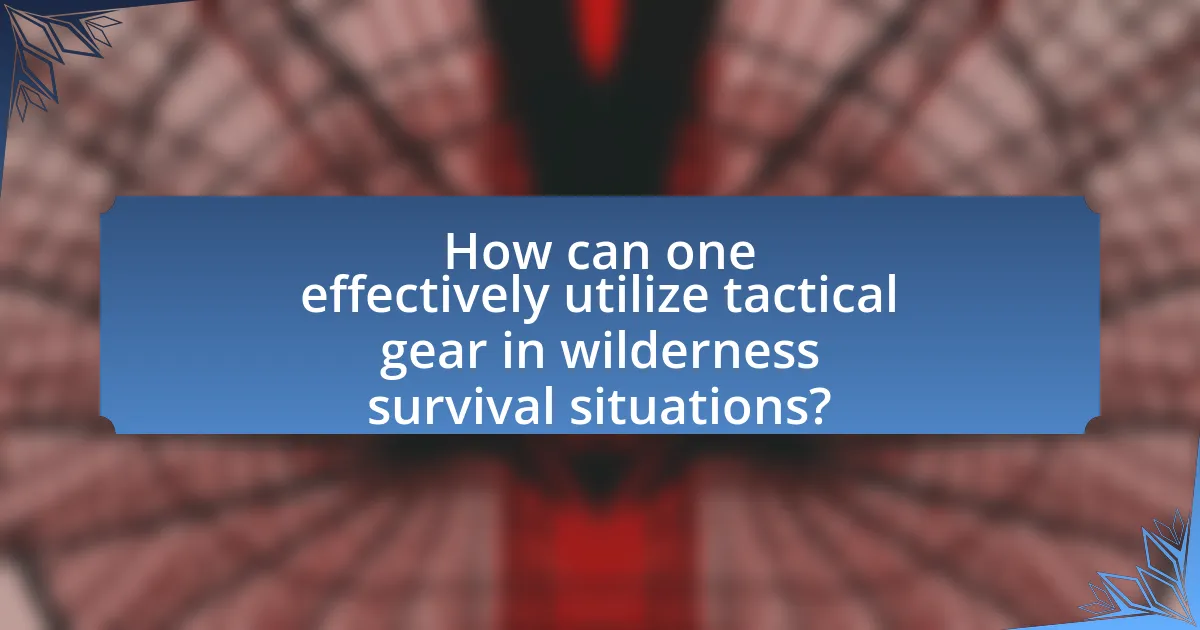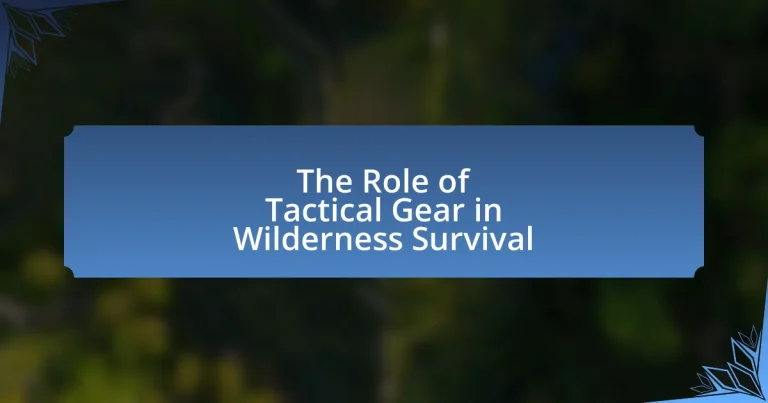Tactical gear is essential for wilderness survival, providing individuals with the necessary tools and protection to navigate challenging environments. This article explores the critical components of tactical gear, including durable backpacks, multi-tools, and weather-resistant clothing, and how they enhance survival capabilities by addressing specific challenges such as exposure to harsh weather, scarcity of resources, and navigation difficulties. It also discusses best practices for utilizing and maintaining tactical gear effectively, emphasizing the importance of proper selection and training to maximize safety and efficiency in wilderness situations.

What is the Role of Tactical Gear in Wilderness Survival?
Tactical gear plays a crucial role in wilderness survival by providing essential tools and protection for individuals in challenging environments. This type of gear is designed for durability, functionality, and adaptability, enabling users to navigate, shelter, and defend themselves effectively. For instance, tactical backpacks often feature multiple compartments for organized storage of survival supplies, while tactical clothing is made from weather-resistant materials that enhance comfort and mobility. Additionally, items like tactical knives and multi-tools are invaluable for tasks such as food preparation, shelter building, and first aid. The effectiveness of tactical gear in wilderness survival is supported by its design, which prioritizes user needs in unpredictable conditions, ensuring that individuals are better equipped to handle emergencies and sustain themselves in the wild.
How does tactical gear enhance survival capabilities in the wilderness?
Tactical gear enhances survival capabilities in the wilderness by providing essential tools and protection that improve safety and efficiency. This gear typically includes items such as multi-tools, durable clothing, hydration systems, and first aid kits, which are designed for rugged environments. For instance, multi-tools can perform various functions, from cutting to repairing equipment, thereby reducing the need to carry multiple items. Additionally, tactical clothing is often made from weather-resistant materials, offering protection against the elements, which is crucial for maintaining body temperature and preventing hypothermia. Hydration systems ensure access to water, a vital resource for survival, while first aid kits allow for immediate treatment of injuries, minimizing the risk of complications. Collectively, these features of tactical gear significantly increase an individual’s ability to navigate and endure challenging wilderness conditions.
What are the essential components of tactical gear for wilderness survival?
The essential components of tactical gear for wilderness survival include a durable backpack, a reliable knife, a first aid kit, water purification systems, fire-starting tools, and appropriate clothing. A durable backpack is crucial for carrying supplies and gear efficiently, while a reliable knife serves multiple purposes, from food preparation to shelter building. A first aid kit is vital for addressing injuries, and water purification systems ensure access to safe drinking water. Fire-starting tools are necessary for warmth and cooking, and appropriate clothing protects against environmental elements. These components are widely recognized in survival training programs and wilderness preparedness literature, underscoring their importance in enhancing survival chances in the wilderness.
How does each component contribute to overall survival?
Each component of tactical gear contributes to overall survival by enhancing safety, efficiency, and resource management in wilderness environments. For instance, a durable backpack allows for the organized transport of essential supplies, ensuring that food, water, and tools are readily accessible. A reliable multi-tool provides versatility, enabling users to perform various tasks such as building shelter, preparing food, or making repairs, which are critical for sustaining life in the wild. Additionally, protective clothing shields against environmental hazards, such as extreme temperatures and injuries, thereby reducing the risk of exposure-related illnesses. Furthermore, navigation tools like compasses and GPS devices help individuals maintain orientation and avoid getting lost, which is vital for finding resources and returning to safety. Collectively, these components create a comprehensive system that maximizes the chances of survival by addressing the fundamental needs of shelter, sustenance, safety, and navigation.
Why is tactical gear important for wilderness survival?
Tactical gear is important for wilderness survival because it enhances safety, functionality, and adaptability in challenging environments. This type of gear is designed to withstand harsh conditions, providing durability and reliability that standard clothing and equipment may lack. For instance, tactical backpacks often feature multiple compartments for organized storage, allowing easy access to essential survival tools like first aid kits, water purification systems, and navigation aids. Additionally, tactical clothing is typically made from moisture-wicking and weather-resistant materials, which help regulate body temperature and protect against the elements. The use of tactical gear can significantly increase the chances of survival by ensuring that individuals are well-equipped to handle emergencies, navigate difficult terrains, and maintain their physical well-being in the wilderness.
What specific challenges does wilderness survival present?
Wilderness survival presents specific challenges such as exposure to harsh weather conditions, scarcity of food and water, navigation difficulties, and potential encounters with wildlife. These challenges require individuals to possess essential survival skills and knowledge to effectively manage risks. For instance, exposure to extreme temperatures can lead to hypothermia or heatstroke, while a lack of potable water can result in dehydration within a few days. Additionally, navigating unfamiliar terrain without proper tools can lead to disorientation and increased danger. Understanding these challenges is crucial for effective wilderness survival, as evidenced by survival training programs emphasizing the importance of preparation and adaptability in unpredictable environments.
How does tactical gear address these challenges?
Tactical gear addresses challenges in wilderness survival by providing specialized equipment designed for durability, functionality, and adaptability. This gear includes items such as multi-tools, weather-resistant clothing, and hydration systems that enhance survival capabilities in harsh environments. For instance, multi-tools combine various functions, allowing users to perform tasks like cutting, screwing, and opening cans without carrying multiple items, thus reducing weight and increasing efficiency. Additionally, weather-resistant clothing protects against elements like rain and cold, which can be critical for maintaining body temperature and preventing hypothermia. Hydration systems ensure access to water, which is vital for survival, especially in remote areas. These features collectively enhance the user’s ability to navigate, protect themselves, and sustain their needs in wilderness settings.

What types of tactical gear are most effective for wilderness survival?
The most effective types of tactical gear for wilderness survival include multi-tools, tactical knives, durable backpacks, fire-starting kits, and first aid supplies. Multi-tools provide versatility for various tasks, while tactical knives are essential for cutting and preparing food or building shelter. Durable backpacks are designed to carry essential gear comfortably over long distances. Fire-starting kits ensure the ability to create warmth and cook food, and first aid supplies are critical for addressing injuries in remote areas. These items are widely recognized in survival training programs and outdoor survival literature as fundamental for enhancing safety and self-sufficiency in wilderness environments.
What are the key categories of tactical gear used in wilderness survival?
The key categories of tactical gear used in wilderness survival include shelter, clothing, tools, navigation equipment, and first aid supplies. Shelter gear, such as tents and tarps, provides protection from the elements. Clothing, including weather-resistant and durable fabrics, ensures comfort and safety in various conditions. Tools encompass knives, multi-tools, and fire-starting equipment, essential for food preparation and survival tasks. Navigation equipment, like compasses and GPS devices, aids in route finding and orientation. First aid supplies are critical for addressing injuries and health issues in remote settings. Each category plays a vital role in enhancing survival chances in wilderness environments.
How do clothing and footwear play a role in survival?
Clothing and footwear are essential for survival as they provide protection from environmental elements, enhance mobility, and prevent injuries. Proper clothing, such as insulated layers, shields the body from extreme temperatures, while waterproof materials keep individuals dry in wet conditions. Footwear designed for rugged terrain offers support and traction, reducing the risk of slips and falls. For instance, studies show that hypothermia can occur in temperatures as mild as 50°F when individuals are wet and improperly dressed, highlighting the importance of appropriate clothing. Additionally, durable footwear can prevent foot injuries, which are critical in survival situations where mobility is vital.
What types of tools and equipment are essential for survival?
Essential tools and equipment for survival include a multi-tool, fire starter, water purification system, first aid kit, and a durable knife. A multi-tool provides various functions such as cutting, screwing, and opening cans, which are crucial in survival situations. A fire starter is vital for warmth and cooking, while a water purification system ensures access to safe drinking water, reducing the risk of waterborne diseases. A first aid kit is necessary for treating injuries, and a durable knife is essential for tasks like food preparation and shelter building. These items are widely recognized in survival training programs and wilderness survival literature as fundamental for ensuring safety and sustainability in the wild.
How do different environments affect the choice of tactical gear?
Different environments significantly influence the choice of tactical gear by dictating the materials, features, and functionalities required for optimal performance. For instance, in arid environments, gear must be lightweight and breathable to prevent overheating, while in cold climates, insulation and waterproofing become critical to maintain body heat and dryness. Additionally, environments with dense vegetation may necessitate camouflage patterns and durable materials to withstand abrasion, whereas urban settings might prioritize versatility and concealment. The U.S. Army’s “Tactical Combat Casualty Care” guidelines emphasize the importance of selecting gear based on environmental conditions to enhance operational effectiveness and safety.
What gear is best suited for cold climates?
The best gear suited for cold climates includes insulated jackets, thermal base layers, waterproof outer layers, insulated gloves, and warm hats. Insulated jackets, such as those made with down or synthetic materials, provide essential warmth by trapping body heat. Thermal base layers, typically made from materials like merino wool or synthetic fabrics, wick moisture away from the skin while retaining heat. Waterproof outer layers protect against wind and moisture, which are critical in cold environments. Insulated gloves and warm hats are vital for preventing heat loss from extremities, as a significant amount of body heat escapes through the head and hands. These gear components are essential for maintaining body temperature and ensuring survival in harsh cold conditions.
How should gear be selected for hot and humid conditions?
Gear for hot and humid conditions should be lightweight, breathable, and moisture-wicking to ensure comfort and prevent overheating. Selecting materials such as synthetic fabrics or merino wool enhances ventilation and helps manage sweat effectively. Research indicates that breathable fabrics can reduce body temperature by allowing sweat to evaporate, which is crucial in high humidity environments where moisture retention can lead to discomfort and heat-related illnesses. Additionally, choosing light-colored clothing can reflect sunlight, further aiding in temperature regulation.

How can one effectively utilize tactical gear in wilderness survival situations?
One can effectively utilize tactical gear in wilderness survival situations by ensuring that the gear is appropriate for the specific environment and needs. Tactical gear, such as multi-tools, tactical backpacks, and durable clothing, enhances survival capabilities by providing essential tools for shelter building, food procurement, and navigation. For instance, a multi-tool can assist in cutting branches for shelter or preparing food, while a tactical backpack allows for organized storage of supplies, making them easily accessible. Studies indicate that individuals equipped with tactical gear are better prepared for emergencies, as it increases their ability to adapt to changing conditions and enhances overall survival rates.
What are the best practices for using tactical gear in the field?
The best practices for using tactical gear in the field include proper training, regular maintenance, and situational awareness. Proper training ensures that users can effectively operate their gear, such as firearms and communication devices, which is crucial for safety and efficiency in high-stress situations. Regular maintenance of tactical gear, including cleaning and inspecting equipment, prevents malfunctions and extends the lifespan of the gear. Situational awareness involves understanding the environment and potential threats, allowing users to make informed decisions about when and how to utilize their gear effectively. These practices are supported by military training protocols, which emphasize the importance of preparedness and adaptability in dynamic environments.
How can one ensure their gear is properly maintained?
To ensure gear is properly maintained, one should regularly inspect, clean, and store it according to manufacturer guidelines. Regular inspections help identify wear and tear, while cleaning removes dirt and moisture that can cause damage. Proper storage protects gear from environmental factors that may lead to deterioration. For example, the U.S. Army recommends routine maintenance checks for tactical gear to extend its lifespan and functionality, emphasizing that neglect can lead to equipment failure in critical situations.
What techniques can enhance the effectiveness of tactical gear?
Techniques that can enhance the effectiveness of tactical gear include proper fit, modularity, and material selection. Ensuring that tactical gear fits well allows for greater mobility and comfort, which is crucial in wilderness survival scenarios. Modularity enables users to customize their gear according to specific needs, allowing for the attachment of additional pouches or tools that can be vital in survival situations. Additionally, selecting high-quality, durable materials enhances the gear’s resilience against environmental factors, such as moisture and abrasion, thereby increasing its longevity and reliability. For instance, gear made from Cordura nylon is known for its strength and resistance to wear, making it a preferred choice among survivalists.
What common mistakes should be avoided when using tactical gear?
Common mistakes to avoid when using tactical gear include improper fit, neglecting maintenance, and failing to understand the gear’s intended use. An improper fit can lead to discomfort and hinder mobility, which is critical in survival situations. Neglecting maintenance can result in gear malfunction, as dirt and wear can compromise functionality. Additionally, using gear for purposes it was not designed for can lead to ineffective performance; for example, using a tactical backpack for heavy-duty hiking without considering weight distribution can cause strain. These mistakes can significantly impact survival outcomes in wilderness scenarios.
How can improper use of gear lead to dangerous situations?
Improper use of gear can lead to dangerous situations by increasing the risk of accidents and injuries in wilderness survival scenarios. For instance, using a knife incorrectly can result in cuts or lacerations, while wearing ill-fitting climbing harnesses can lead to falls. Statistics show that 30% of outdoor injuries are attributed to equipment misuse, highlighting the critical importance of proper gear handling. Additionally, failure to understand the functionality of gear, such as not securing a tent properly, can expose individuals to harsh weather conditions, further endangering their safety.
What are the signs of inadequate gear selection?
Signs of inadequate gear selection include discomfort during use, inability to perform necessary tasks, and increased fatigue. Discomfort can manifest as chafing or excessive weight, indicating that the gear does not fit properly or is not suited for the activity. An inability to perform tasks, such as difficulty in accessing tools or equipment, suggests that the gear lacks functionality or is poorly organized. Increased fatigue often results from using gear that is too heavy or not designed for the specific environment, leading to decreased efficiency and effectiveness in survival situations. These signs highlight the importance of selecting appropriate gear tailored to the specific demands of wilderness survival.
What practical tips can enhance wilderness survival with tactical gear?
To enhance wilderness survival with tactical gear, individuals should prioritize the selection of versatile, durable equipment tailored to specific environments. For instance, a multi-tool can serve various functions, from cutting to repairing gear, which is essential in survival situations. Additionally, utilizing a tactical backpack with organized compartments allows for efficient storage and quick access to critical items like first aid kits, water purification systems, and fire-starting tools.
Moreover, wearing tactical clothing made from moisture-wicking and weather-resistant materials can improve comfort and protection against the elements. Research indicates that proper clothing significantly impacts survival rates in harsh conditions. Furthermore, regular training in the use of tactical gear ensures that individuals can operate their equipment effectively under stress, enhancing their overall survival capability.


